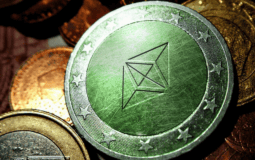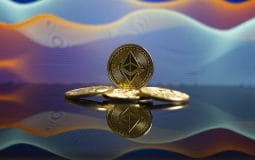Ethereum is a decentralized blockchain network powered by the Ether token. With Ethereum, users can conduct transactions, stake their holdings to earn interest, utilize and store nonfungible tokens (NFTs),
Participants have complete ownership and visibility over transaction data thanks to the immutable, verifiable, and secure distribution of transaction records throughout the network.
User-created Ethereum accounts are where transactions are transmitted and received. As part of the network’s transaction processing fees, senders must sign transactions and use Ether, Ethereum’s native coin.
Ethereum Classic (ETC): What Is It?
An Ethereum (ETH) hard fork called Ethereum Classic (ETC) was introduced in July 2016. Its primary role is that of a network for smart contracts, which may host and support decentralized apps. ETC is its native token.
Since its inception, Ethereum Classic has worked to set itself apart from Ethereum, and as time goes on, the two networks’ technological roadmaps are becoming increasingly dissimilar.
After a significant hacking incident that resulted in the theft of 3.6 million ETH, Ethereum Classic initially set out to protect the integrity of the current Ethereum blockchain.
What is the Ethereum Classic price?
The Ethereum Classic price is constantly varying. The news may impact the cost of ETC, partnerships, new exchange listings, adoption by businesses or users, upgrades and updates, and dev team activities.
How Does Ethereum Function?
Ethereum is said to have been created by Vitalik Buterin, who 2014 released a white paper introducing it. Buterin and Joe Lubin, the creator of the blockchain software firm ConsenSys, introduced the Ethereum platform in 2015.
Ether has grown to be the second-largest cryptocurrency by market value since the introduction of Ethereum. Only Bitcoin outranks it.
The following are Ethereum’s advantages.
• A sizable, current network.
The advantages of Ethereum include a tried-and-true network that has been tested during years of operation and through the exchange of trillions of dollars in value.
It has the most significant blockchain and cryptocurrency ecosystem and a sizable and devoted global community.
• A large variety of functions.
Ethereum can perform different types of financial transactions, carry out smart contracts, and store data for third-party applications in addition to being a digital currency.
• Perpetual innovation
A sizable group of Ethereum developers is always searching for fresh approaches to enhance the network and create new applications.
• Eliminates intermediaries.
With Ethereum’s decentralized network, users can do away with third-party intermediaries like banks that operate as middlemen in financial transactions, attorneys who draft and interpret contracts, and site hosting providers.
Risks connected to Ethereum investment:
• Volatility.
This isn’t a drawback for Ethereum because all cryptocurrencies are volatile. Therefore this fact alone doesn’t necessarily make Ethereum a terrible investment.
• High transaction fees.
Transaction fees, perhaps Ethereum’s biggest flaw, prevent the network from becoming adopted.
• New legislation.
New rules could obstruct business strategies and result in crashes that are entirely beyond your control.
• Internet hacking threat.
A risk that many bitcoin investors face is hacking. You can typically buy and trade cryptocurrency using a mobile app or website.
• Competition.
Ethereum is facing stiff competition from many new innovative contract platforms.
Who Is the Ethereum Founder?
Programmer Vitalik Buterin, a Russian-Canadian who continues to serve as the de facto leader of Ethereum, made the original proposal for the cryptocurrency.
In 2013, Buterin published a whitepaper outlining an alternative blockchain network that would go beyond Bitcoin’s suggested financial use cases and enable programmers to build their decentralized applications (dApps) using a new programming language.
The whitepaper of the creator of Ethereum generated a lot of buzz among early cryptocurrency supporters. Immediately after its release, several brilliant engineers contacted Buterin to assist in realizing his idea.
As a result, several initial members are given credit for creating Ethereum. The original Ethereum co-founders, in addition to Buterin, are:
• Charles Hoskinson:
An American businessman named Charles Hoskinson served as Ethereum’s interim CEO. Hoskinson then helped establish IOG, an engineering and research firm that developed Cardano.
• Anthony Di Iorio:
Di Iorio was a proponent of Bitcoin and helped make Ethereum successful in its early branding and marketing efforts.
• Mihai Alisie:
When Ethereum was still in its infancy, Alisie established the Swiss corporation, providing it with a legal and financial base. Mihai Alisie served as Vice President of the Ethereum Foundation.
Early in 2014, the Ethereum project expanded to include three additional significant individuals who are frequently referred to in the media as co-founders of Ethereum:
• Joseph Lubin:
Before joining Ethereum, Lubin, a computer scientist from Princeton, worked for Goldman Sachs. Lubin is credited with launching ConsenSys, a Brooklyn-based firm that aims to provide the Ethereum ecosystem with infrastructure and applications, and the Ethereum Foundation.
• Gavin Wood:
English computer scientist Gavin Wood developed the first Ethereum test net. The “technical bible” that describes the specifications for the ledger and smart contracts used by the Ethereum network was written by Wood. Wood founded Polkadot in 2016 after quitting Ethereum.
• Jeffrey Wilcke:
A version of the Ethereum platform was translated into Google’s Go programming language by Jeffrey Wilcke, who is a programmer, and this resulted in Go Ethereum.



